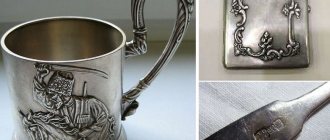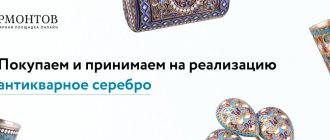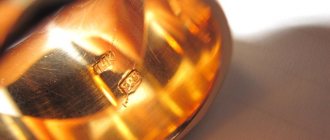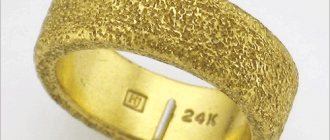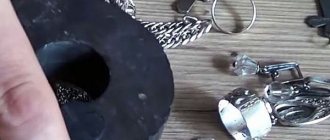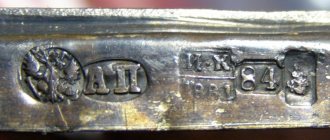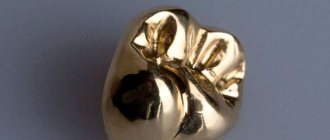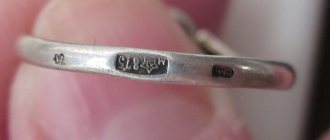Each mark on silver belongs to one or another assay system. For example, the hallmark of 84 hallmarks refers to the ancient hallmark system, which is called “spool”. This is how silverware was branded even before the revolution, although this method was actively used in the USSR. The 84 silver hallmark appeared at the end of the 18th century, but other markings also exist. Now craftsmen work according to the metric system and test products according to a special table. The set will highlight the hallmarking of precious metals, their principles and types of alloys that are subject to assaying.
What does a hallmark mean on silver items?
You will not find such marks on silver bars, which do not have impurities. The fact is that pure precious metal is very soft and is not intended for creating jewelry or decorations. Craftsmen deliberately began to add other impurities to these metals in order to make the raw material harder and more convenient for processing. In addition, objects made of pure metal have the ability to lose shape.
These may be various components that will be indicated in the product certificate. The most popular additives were considered to be zinc, aluminum, copper and cadmium. Based on the amount of impurities in ounces, the fineness of the silver or other precious metal can be determined. The hallmarking system prescribes the percentage of pure silver in the alloy.
What does a hallmark mean on silver items?
On a note! The number of the hallmark on silver objects or jewelry means how many shares of silver are present in the product, and how many shares of additional impurity.
History of the Assay System
Not only numbers are used by the assay system, but also letters. If previously the sample carried more detailed information: the value of the item, the name of the jewelry maker and even the date of manufacture, now branding occurs strictly according to a system table. In Rus' this art has been studied for a long time. Only the master himself or his chief assistant could set samples. At the beginning of the 19th century, the Russian emperor even issued a decree that special chambers should be equipped for hallmarking silver and other metals.
The marking system has evolved, and along with it, the print itself will periodically change. There was one for each category of precious metals. The first print was in the form of a woman’s head in a kokoshnik, but each individual district in the Russian Empire had its own mark, on which letters were printed. They were the initials of the head of the district. Then it was decided to put an abbreviation according to the regions. At that time in Russia there were many German craftsmen who made their products from silverware with personalized names.
A unified testing system appeared under Peter the Great, in 1899. It was he who obliged the craftsmen to indicate the sample on the precious metal so that they could roughly determine the value of the item. An interesting fact is that on the first print the woman’s profile was turned to the left, and the mark itself was a primitive design. When high-quality fakes of the sample began to appear, it was decided to complicate the mark and in the final version, people saw the woman’s face, already turned to the right. In addition to this change, the craftsmen added additional touches to the image so that fraudsters could not fake it without special skills and equipment.
On a note! After approval of the new brand, each district additionally put down the letter abbreviation of its district.
Types of hallmarks on silver
Over the entire era of the stamp, there are several dozen impressions. They appeared at one time or another and were not all included in the official marking table. Some positions have survived to this day, but the main part has sunk into history. Now you can find sample No. 875, and the alloy in composition and characteristics is identical to that which was branded under number 84. This is due to the fact that sample 84 belongs to the spool system, and 875 to the metric system, which was created in 1927. Alloy 925 is also popular in the modern world.
The stamp itself can be made in the form of an oval, the sides of which are slightly cut off. There should always be a letter at the bottom of the stamp. Using it you can find out in which region or locality the product was tested. Since ancient times, branding has been handled by a separate department, which simultaneously evaluates the item based on chemical analysis of individual components. This procedure can be done manually, during jewelry making, or using a special device. Brands are written with the following symbols: “A”, “B”, “C”, “D”, “D”, “E”, “F”, “Z”, where:
- A and B are a round print with a woman’s head, and the sample is located behind the circle, near the image.
- C and D – a round print with a five-pointed star, with a hammer and sickle inside, and the sample is located behind the circle, near the image. This mark dates back to the USSR era.
- “D”, “E”, “F”, “Z” - do not have independent meaning. It is applied as an additional stamp. Without a standard stamp, such a marking cannot confirm that the item is created from silver metal.
In modern jewelry, only the meanings of “D” and “E” are used. The first letter is depicted on precious things, enclosed in a rectangle, the ends of which are slightly rounded. The letter designation "E" is used extremely rarely. It is placed on products that do not correspond to the declared sample. Again, this is done in the approbation department, because each metal unit must undergo appropriate testing.
In modern jewelry, only the values of “D” and “E” are used.
It should be noted that the letter “B” is placed on some items after production. It may mean that the products will be exported abroad or, on the contrary, have arrived in Russia. Without this sign, the goods simply will not be allowed through the customs zone. In this print, instead of a woman wearing a kokoshnik, a sea vessel is depicted. If a person comes across jewelry with such a stamp, it means that it was either made abroad or came from there.
Many jewelry factories create their own stamps, but the presence of name marks does not replace the main stamp, which confirms the composition of the alloy by a competent department. Only those companies that do not claim to confirm individual components of the product can make do with a personal imprint. This is what workshops do that produce expensive jewelry and give it a presentable appearance with silver plating. There are also so-called “holiday” or “temporary” stamps:
- In 1967, an astronaut was present in the oval for 60 days. This seal was made for the 50th anniversary of the October Revolution. Many antique lovers keep silver coins with this sign.
- Until 1994, jewelry workshops that created church paraphernalia from silver could only brand it with the letter “D.” Now the church again wants to achieve its own distinctive sign, but so far their request is not being considered by the state.
- Also, until 1997, all medals that were issued to heroes of the Soviet Union and people for their contribution to the development of the state were subject to branding.
On a note! In the Soviet Union, it took a long time to displace German stamps. Devices with this imprint can still be found to this day, but most of them are in a museum in Moscow.
Names and letter designations of jewelry (code)
Bracelets B , BR ; Brooches BR , BS , B ; Vases B ; VL plugs ; Decanters G ; Clamps 3 ; Cufflinks ZP ; ZN icons ; KL necklace ; Rings K ; KB Cups ; KN pendants ; Spoons L ; Spatulas for cakes LP ; Medallions M ; Thimbles N ; Leaf cutter knives NL ; Knives NZh ; Necklaces O ; Ashtrays P , PP ; Cup holders PD ; Egg coasters PYA ; Cigarette cases PR ; Powder compacts PDN ; Sockets P ; RM glasses ; Sugar bowls CX ; Earrings C ; Salt shakers SL ; Stacks ST ; Chains C ; Cups H ; Teapots CHN ; Sugar tongs Shch .
The passport was accompanied by a photograph of the product and, as the main control document, was kept (one copy each) in the files of the manufacturing enterprise, the wholesale trade base - the customer and the central department, the system of which included the enterprise that produced this product. In the quality control department of the manufacturing enterprise and at the wholesale trade base (in the assortment office or in the sample room), one copy of control samples (standards) of these products was constantly stored. Labels were attached to the standards under the seal, which included: the name of the manufacturer, the name of the product, the factory code, metal, weight, date and place of approval of the sample, price and price list item. The price and article number were also included in the passport. When setting the price, the product was assigned a corresponding product article - a number under which it was entered into the price list. Due to the constant updating of the assortment and the discontinuation of products of outdated styles, with each edition of a new price list there was some movement of items. The article numbers under which discontinued products were listed in the price list were assigned to newly produced products.
The article was a four-digit number, the first two digits of which indicated a group of products, the next digits indicated the serial number of the product for each group.
The indexes for product groups are as follows: gold - bracelets 01, brooches 02, pins 03, dental products 04, cufflinks 05, rings 06, pendants and necklaces 07, medallions 08, earrings 09, cigarette cases 10, chains 11; products with garnet stones 12, filigree 13, gold leaf 14, various products 16; coral beads 15; silver products by weight 25, piece 28, bracelets 30, hat pins 31, brooches 32, cufflinks 33, rings 34, pendants and necklaces 35, medallions 36, cigarette holders 37, thimbles 38, powder boxes 40, cigarette cases 41, earrings 43, chains 44, various 45, amber products 50; jewelry metal haberdashery made of brass and tombac - bracelets 51, brooches 52, pins 53, cufflinks 55, clips 56, earrings 57, pendants 58, medallions 59, powder compacts 60, various 61; cupronickel haberdashery - bracelets 73, brooches 74, buckles 75, cufflinks 76, rings 77, necklace 78, earrings 79, combs 80; made of aluminum 81; products from cupronickel - spoons 62, forks 63, knives 64, spatulas 65, crackers, candy bowls, shot glasses 66, cigarette cases 67, products from nickel silver 70, products from tombac 71-72, cases 69.
With the introduction of a new price list, jewelry that was in the retail chain was subject to relabeling with new items indicated. Products not included in the new price list were sold at the retail prices established for them with the letter “C” (discontinued) added to the article number.
The supply of jewelry to the retail trade network took place through the following channels: enterprise - central or interregional wholesale trading base - interregional or city trading office - store; in some cases, the enterprise is a store. The supply of mass and individual gold jewelry to the republican central wholesale bases was regulated by the USSR State Planning Committee. New product samples (their first batch), mastered by enterprises and approved by all authorities, were sent to the retail chain in small parcels marked “New Products” in order to identify consumer demand for them.
The external design of jewelry stores, in particular their display windows, played an advertising and popularization role. In showcases, they are usually displayed in groups: jewelry for women, toiletries, table setting items and interior decorations, souvenirs, writing instruments, etc. Products were selected either in the same color scheme, or, conversely, a contrasting decision was made both in color and and by the texture of various materials (for example, a group of silver and enamel items looks most colorful next to crystal items, ivory items acquire a more decorative sound next to black papier-mâché boxes with picturesque paintings, etc.). New items were placed directly behind the glass in the front (facade) part of the display case. The entire area of the back glass of the display case was usually draped with theatrical tulle or other translucent fabric. To illuminate the display cases, fluorescent light sources located in the upper part, covered with milk glass or a light-diffusing grille, were used. From the street and store sides, frosted stripes were applied to the display glass in the upper part, which created a surface that scattered light. Sometimes (mainly to display transparent, for example crystal, products) a hidden light source was used, enclosed in a light-weight lamp. In order to use the entire space of the display cases at different heights and in different plans, transparent light shelves made of glass or plastic and small shields on which jewelry were placed were hung on invisible (nylon) threads; part of the space was draped with light fabrics. Enlarged photographs, silhouettes made from bent wire, artificial and fresh flowers, auxiliary tablets and mannequins were also used to decorate the display windows. Lightweight mobile equipment made it possible to frequently change the design of display cases. Typically, the design of shop windows was subordinated by the artist-decorator to a single plot concept: seasons, new items of the season, methods of using various decorations, an exhibition and sale of a particular assortment, amber jewelry, Russian gems, souvenirs and gifts, etc. For in-store decoration and retail equipment The hall used wall cabinets and cabinets in which jewelry was displayed. The most expressive displays of small women's jewelry were large shields-stands, divided into separate sections in the form of circles, rectangles and other figures, covered with single-color dress fabrics, with individual jewelry pinned on them - brooches, rings, earrings, bracelets. To facilitate the selection of goods, posters, inscriptions and annotations were used that characterize certain jewelry items.
Sales of jewelry were usually concentrated in the sections: weighted silver, haberdashery and gold items. Weighted silver, just like gold items, was sold by weight, at prices set per 1 g, depending on one or another artistic treatment. For this purpose, the store had special technical scales of the 1st accuracy class. Haberdashery was sold individually. Some valuable jewelry was sold in cases, which were usually boxes of various shapes with a special slot for the corresponding item, covered on the outside with leather or its substitutes, and lined with silk or velvet on the inside. For cheaper products, cases were used, covered with lederin, with silk, semi-velvet or satin upholstery inside. Even cheaper products were sold in plastic bags or cardboard boxes covered with glossy or matte colored paper.
Rosyuvelirtorg had a special “Sample Room”, where specialists associated with jewelry art, production and trade had the opportunity to get acquainted with modern jewelry of domestic and foreign production.
Principles of branding
The mark can be located inside or outside the product. The very first and most popular method is mechanical. Every jewelry maker should have this art. At first, an ordinary hammer was used for this, and then a special mechanism was made that carried out the process automatically. There were also special anvils, without which it was almost impossible to accurately apply a jewelry stamp. The machines had already been introduced when mass branding was required.
The electric spark method is carried out with the participation of electrodes
The electric spark method is carried out with the participation of electrodes. For this purpose, a special installation was made, with the help of which the print is burned out with a spark. If the brand has jumpers at the top between the outline and the badge, it means that this item was branded using the electric spark method. This method is more effective, but not all jewelry workshops and factories use it, because such an installation costs a lot of money.
For very expensive jewelry, a special laser can be used, which applies the mark very carefully. This method is not as relevant in mass production because the laser mark disappears over time. If a person has purchased such a product, then he needs to treat it more carefully, because after a while the mark will simply disappear and it will no longer be possible to confirm that the jewelry belongs to the precious right.
IMPORTANT! It is not so difficult to fake a sample, but the master will immediately understand that it is not real. In Soviet times, it was precisely because of the work of scammers that the prints changed several times. Most often, counterfeit items were found in silver dishes.
Reviews
Maria:
“My grandmother gave me a ring, no stone, just a nice ring with a small pattern. On the inside there is an o, which, as I later learned, means a test. At first I doubted that we have a three-digit standard system for gold. I googled it and it turned out to be simple: the ring was made back in the days of the spool system. What can I say - the ring is beautiful, it has not changed color, does not darken and does not stain the skin. Grandma clearly looked after him, I continue this tradition.”
Konstantin:
“A chain with 56 hallmarks, the lock broke, I turned to the jeweler for help. He suggested installing a new one, made from a modern alloy. There was no choice - I had to replace it. And a year later I got caught on the railing and pulled the chain hard, so the new lock broke, but my father’s 56-grade chain was not damaged anywhere.”
Arina:
“Good gold was made in Tsarist Russia, my father has a ring that has been inherited for several generations, the 56th standard is marked with a hallmark. It does not turn black, does not stain the skin, and does not need to be cleaned often - it’s a pity that there are no such good alloys today.”
Silver alloys subject to hallmarking
They put a mark on many products made of precious metals. The standard mark marks all jewelry that weighs more than three grams. The following items are subject to mandatory branding:
- Having historical value.
- Of archaeological significance.
- Ingots of imported and domestic production.
- Nuggets.
- Silver leaf.
Despite the fact that most of the historical treasures are in the museum, archaeologists find new parts made of precious metals every day. Before transferring them to museum institutions for storage, they are checked and branded with a special sign. Even if the product contains a mixture of alloys, it must have a sample on it. For example: a ring made of silver and gold: two stamps. Any items made of precious metals that are created for scientific or industrial needs are not branded. Such things are subject to special consideration. Such records can be found in journals of laboratories, medical and other professional institutions.
If a person sees a silver item, but cannot detect a hallmark on it, then most likely this item was made by a private craftsman or does not belong to precious alloys. When products are sealed, each item is indicated in a special registration book. The authenticity of the sample can be confirmed or refuted by any jeweler with a magnifying glass at hand.
How much does 1 gram of gold of this standard cost?
The price of gold is determined by the Central Bank of the Russian Federation. But the market value has different meanings for scrap and jewelry. Jewelry often has historical value, so its evaluation should be carried out by a specialist. In this case, the price is influenced by the presence of precious stones, the mark of the jeweler, who used the jewelry and other factors.
| Price 999 standard according to the Central Bank | Market value of the sample today | Scrap price | Price in jewelry |
